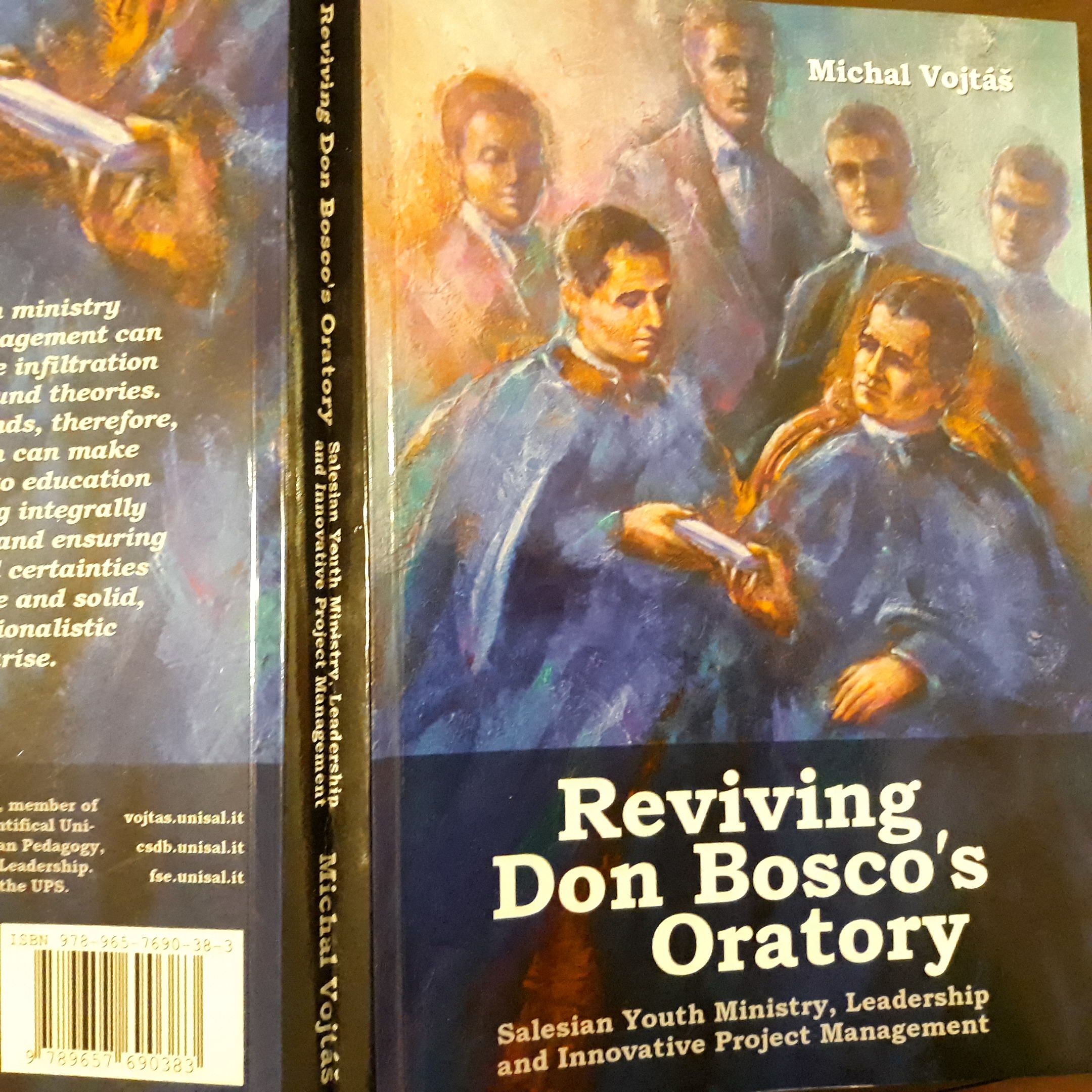By Fr. Michal Vojtas, SDB
UPS - ROME
Reviving Don Bosco's Oratory
Salesian Youth Ministry, Leadership and Innovative Project Management
ed. 2017 (Jerusalem - STS Publication, Centro Studi Don Bosco - UPS, Rome)
Download: Vojtas-Reviving-DBs-Oratory.pdf

Contents
INTRODUCTION ................................................................................................9
1. HISTORICAL EVOLUTION OF THE SALESIAN YOUTH MINISTRY ....13
1.1 The Pastoral Echoes of Vatican II in the 19th General Chapter (1965) 14
1.1.1 General Chapter Methodology ............................................................................................ 14
1.1.2 Implications for the Youth Ministry ...................................................................................... 16
1.1.3 Execution of Pastoral Conclusions and Recommendations ............................................... 18
1.2 The Post-Vatican II and the Special General Chapter (1966-72) 21
1.2.1 The Crisis and the Special General Chapter Preparations ................................................. 22
1.2.2 Special General Chapter .................................................................................................... 25
1.2.3 Application of the SGC guidelines ...................................................................................... 27
1.3 Educative and Pastoral Project Logic of Viganò and Vecchi (1978-90) 30
1.3.1 SEPP as the Actualization of the Preventive System ......................................................... 31
1.3.2 Salesian Educative and Pastoral Project as an Operational Tool ...................................... 33
1.3.3 SEPP in the Youth Ministry Department Handouts (1978-80)............................................ 36
1.4 Collaboration between the Youth Ministry Department and the UPS (1980-88) 45
1.4.1 Seminar on “Planning Education Today with Don Bosco” .................................................. 46
1.4.2 Publication of “Modular Elements of the Salesian Educational Project” ............................. 48
1.4.3 Conference on “Educative and Pastoral Practice and the Sciences of Education” ............ 51
1.4.4 Evaluation of the SEPP implementation in the ‘80s ........................................................... 53
1.5 Consolidation of the SEPP (1990-2002) 56
1.5.1 GC23 and the Programmes of Education to the Faith ........................................................ 57
1.5.2 Revision of the Provincial SEPPs in the early ‘90s ............................................................. 60
1.5.3 Synthesis of the First Two Editions of the “Frame of Reference” (1998, 2000) ................. 65
1.5.4 “Planning Mentality” that Implies an Unsustainable Number of Projects (2002) ................ 70
1.6 New Youth Ministry Challenges and Perspectives (2002-2014) 71
1.6.1 “Planning Mentality” as a Broader Holistic Concept ........................................................... 72
1.6.2 Cereda and Domènech’s Method of Discernment .............................................................. 74
1.6.3 Changed Perspectives in the Third Edition of the “Frame of Reference” ........................... 76
2. THEORETICAL BACKGROUNDS OF SALESIAN LEADERSHIP AND PROJECT MANAGEMENT
2.1 Curriculum Design Influences from Bobbitt through Tyler to Stenhouse 82
2.1.1 Product Model ..................................................................................................................... 84
2.1.2 Process Model .................................................................................................................... 91
2.1.3 Research Model .................................................................................................................. 93
2.1.4 Critical Evaluation of the Models of Curriculum Design ...................................................... 96
2.2 Animation as a Theoretical Leadership Model 100
2.2.1 Cultural Animation ............................................................................................................ 101
2.2.2 Social Animation ............................................................................................................... 105
2.2.3 Animation Theories Critical Evaluation ............................................................................. 108
2.3 Management by Objectives and Beyond 110
2.3.1 Management by Objectives .............................................................................................. 110
2.3.2 Critics of Management by Objectives ............................................................................... 112
2.3.3 Change of Organizational Paradigm................................................................................. 117
3. DON BOSCO IN THE ORATORY: PERMANENT RENEWAL CRITERION
3.1 Criterion for Vatican II Renewal Needed and Found 127
3.1.1 SGC’s Description of “Don Bosco in the Oratory” ............................................................ 129
3.1.2 Criterion’s Application Contextualized .............................................................................. 131
3.1.3 Further Applications of the Criterion Needed ................................................................... 134
3.2 Consecrated Life and Organizational Research 136
3.2.1 Consecrated Leadership as a Universal Model ................................................................ 136
3.2.2 Comparative Studies between Consecrated and Secular Settings .................................. 138
3.2.3 Leadership Theories Applied to Consecrated Life ............................................................ 140
3.2.4 Other Organizational Studies Written by SDBs or FMAs ................................................. 142
3.3 Don Bosco’s Leadership and Management 144
3.3.1 The Various “Worlds” in the Life of Don Bosco ................................................................ 145
3.3.2 Don Bosco’s Childhood and Formation (1815-1841) ....................................................... 150
3.3.3 Encounter with the Reality of the Young in Turin (1841-1846) ......................................... 156
3.3.4 Development of the Oratory and the Adjoined House (1846-1863) ................................. 161
3.3.5 Collegialization, Foundations and Missions (1863-1888) ................................................. 166
3.3.6 The Preventive System, Leadership and Management.................................................... 174
3.4 Conclusion: Leadership – Management Synergy in Don Bosco 180
4. INNOVATION OF SALESIAN LEADERSHIP AND PROJECT MANAGEMENT
4.1 Dialogue with Organizational Theories 183
4.1.1 Criteria for the Selection of Organizational Models .......................................................... 183
4.1.2 Peter M. Senge’s Organizational Learning ....................................................................... 187
4.1.3 Stephen R. Covey’s Principle-Centered Ethical Leadership ............................................ 193
4.1.4 Otto C. Scharmer’s “Vocational” Theory Linked to Second Senge and Covey ................ 199
4.1.5 Evaluation of Selected Models ......................................................................................... 205
4.2 Integral Methodological Framework 208
4.2.1 Knowing the Whole ........................................................................................................... 209
4.2.2 Enacting the Whole ........................................................................................................... 213
4.3 Virtues of Salesian Leader-Manager 218 4.3.1 Dynamic Fidelitty....................................... 220
4.3.2 Call Discernment............................................................................................................... 225
4.3.3 Operational Consistency ................................................................................................... 232
4.3.4 Abundance Mentality ........................................................................................................ 238
4.3.5 Generative Accompaniment ............................................................................................. 245
4.3.6 Synergic Integration .......................................................................................................... 252
4.4 Process of an Integral and Transformational Project Management 258
4.4.1 Don Bosco’s “Project Methodology” ................................................................................. 260
4.4.2 Integral SEPP Methodology .............................................................................................. 263
4.4.3 Stage 1: Described Situation ............................................................................................ 266
4.4.4 Stage 2: Communitarian Interpretation ............................................................................. 267
4.4.5 Stage 3: Embraced Vocation ............................................................................................ 270
4.4.6 Stage 4: Experimented Vision .......................................................................................... 273
4.4.7 Stage 5: Operational Planning .......................................................................................... 275
4.4.8 Application of the SEPP Integral Methodology ................................................................. 278
APPENDIX 1 – SDB GENERAL CHAPTERS (1958-2014) ........................... 284
APPENDIX 2 – THEORIES, THEIR EVOLUTION AND RELATIONS ........... 285
APPENDIX 3 – FEEDBACK FROM A PILOT PROJECT .............................. 286
INDEX ............................................................................................................ 288
LIST OF SCHEMES ....................................................................................... 295
BIBLIOGRAPHY ............................................................................................ 296
CONTENTS ....................................................................................................
Cover - Back

 2018 - Year of the Young
2018 - Year of the Young
 Youth Ministry delegate formation
Youth Ministry delegate formation























